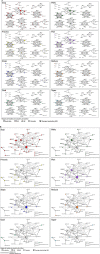A systematic review of the emerging definition of 'deprescribing' with network analysis: implications for future research and clinical practice
- PMID: 27006985
- PMCID: PMC4693477
- DOI: 10.1111/bcp.12732
A systematic review of the emerging definition of 'deprescribing' with network analysis: implications for future research and clinical practice
Abstract
Aims: The aim of this study was to identify what definitions have been published for the term 'deprescribing', and determine whether a unifying definition could be reached. A secondary aim was to uncover patterns between the published definitions which could explain any variation.
Methods: Systematic literature searches were performed (earliest records to February 2014) in MEDLINE, Embase, CINAHL, Informit, Scopus and Google Scholar. The terms deprescrib* or de-prescrib* were employed as a keyword search in all fields. Conventional content analysis and word frequencies were used to identify characteristics of the definitions. Network analysis was conducted to visualize characteristic distribution across authors and articles.
Results: Following removal of duplicates, 231 articles were retrieved, 37 of which included a definition. Eight characteristics of the definitions were identified: use of the term stop/withdraw/cease/discontinue (35 articles), aspect of prescribing included e.g. long term therapy/inappropriate medications (n = 18), use of the term 'process' or 'structured' (n = 13), withdrawal is planned/supervised/judicious (n = 11), involving multiple steps (n = 7), includes dose reduction/substitution (n = 7), desired goals/outcomes described (n = 5) and involves tapering (n = 4). Network analysis did not reveal patterns responsible for variations in previously used definitions.
Conclusions: These findings show that there is lack of consensus on the definition of deprescribing. This article proposes the following definition: 'Deprescribing is the process of withdrawal of an inappropriate medication, supervised by a health care professional with the goal of managing polypharmacy and improving outcomes'. This definition has not yet been externally validated and further work is required to develop an internationally accepted and appropriate definition.
Figures



Comment in
-
Rationalising medications through deprescribing.BMJ. 2019 Feb 7;364:l570. doi: 10.1136/bmj.l570. BMJ. 2019. PMID: 30733211 No abstract available.
Similar articles
-
The value of deprescribing in older adults with dementia: a narrative review.Expert Rev Clin Pharmacol. 2021 Nov;14(11):1367-1382. doi: 10.1080/17512433.2021.1961576. Epub 2021 Aug 19. Expert Rev Clin Pharmacol. 2021. PMID: 34311630 Review.
-
Barricades and brickwalls--a qualitative study exploring perceptions of medication use and deprescribing in long-term care.BMC Geriatr. 2016 Jan 15;16:15. doi: 10.1186/s12877-016-0181-x. BMC Geriatr. 2016. PMID: 26767619 Free PMC article.
-
Deprescribing: a new goal focused on the patient.Expert Opin Drug Saf. 2017 Feb;16(2):111-112. doi: 10.1080/14740338.2017.1273347. Epub 2016 Dec 26. Expert Opin Drug Saf. 2017. PMID: 27984921
-
Deprescribing medications in older people: a narrative review.Drugs Today (Barc). 2018 Aug;54(8):489-498. doi: 10.1358/dot.2018.54.8.2856495. Drugs Today (Barc). 2018. PMID: 30209443 Review.
-
[Deprescribing: an essential part of rational pharmacotherapy].Orv Hetil. 2023 Jun 18;164(24):931-941. doi: 10.1556/650.2023.32782. Print 2023 Jun 18. Orv Hetil. 2023. PMID: 37330979 Review. Hungarian.
Cited by
-
Challenging the status quo: deprescribing antihypertensive medication in older adults in primary care.Br J Gen Pract. 2024 Oct 31;74(748):484-486. doi: 10.3399/bjgp24X739689. Print 2024 Nov. Br J Gen Pract. 2024. PMID: 39481908 No abstract available.
-
Minimising Harm and Managing Pain: Deprescribing Opioids in Older Adults.Drugs Aging. 2024 Oct 29. doi: 10.1007/s40266-024-01154-5. Online ahead of print. Drugs Aging. 2024. PMID: 39467997
-
Approaches to Deprescribing Proton Pump Inhibitors in Clinical Practice: A Systematic Review.J Clin Med. 2024 Oct 21;13(20):6283. doi: 10.3390/jcm13206283. J Clin Med. 2024. PMID: 39458232 Free PMC article. Review.
-
Screening for Hypoglycaemia Risk and Medication Changes in Diabetes Patients Using Pharmacy Dispensing Data.J Clin Med. 2024 Sep 30;13(19):5855. doi: 10.3390/jcm13195855. J Clin Med. 2024. PMID: 39407915 Free PMC article.
-
Exploring GP and patient attitudes towards the use and deprescribing of dietary supplements: a survey study in Switzerland.BMC Prim Care. 2024 Oct 3;25(1):359. doi: 10.1186/s12875-024-02605-z. BMC Prim Care. 2024. PMID: 39363317 Free PMC article.
References
-
- Woodward M. Deprescribing: achieving better health outcomes for older people through reducing medications. J Pharm Pract Res 2003; 33: 323–8.
-
- de Vries TPGM, Henning RH, Hogerzeil HV, Fresle DA. Guide to good prescribing. Geneva: World Health Organization, 1995.
-
- Payne R, Avery A, Duerden M, Saunders C, Simpson C, Abel G. Prevalence of polypharmacy in a Scottish primary care population. Eur J Clin Pharmacol 2014; 70: 575–81. - PubMed
Publication types
MeSH terms
LinkOut - more resources
Full Text Sources
Other Literature Sources

